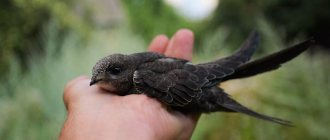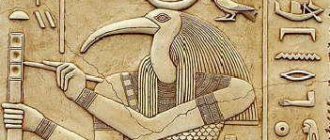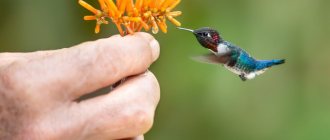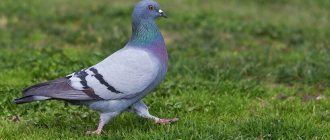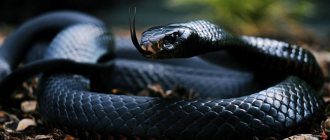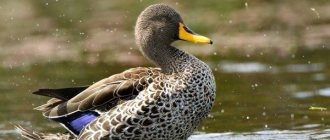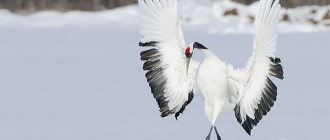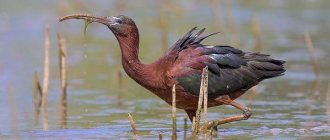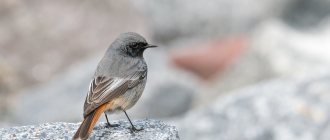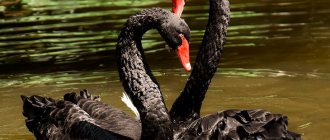An unusual, bright and fascinating bird is the red ibis. A representative of swamp animals is distinguished by its unusual plumage. The large bird belongs to the ibis family, and can be found in South America, Colombia, French Guiana, the Caribbean and Antilles. The most favorable living conditions for animals are considered to be muddy wetlands and the riverbanks of tropical forests.
Appearance
The red ibis is a medium-sized bird, body length up to 70 cm, weight about 500 g. The plumage is bright red, only the tips of the four primaries are black. The beak is thin, curved, usually brownish-red, and black during the mating season. The legs are thin and relatively short, which distinguishes red ibises from most wading birds. Females and males do not differ from each other in appearance; young birds are less brightly colored.
Attempts to revive the population of red-legged ibises
In Japan, in 1966, they decided to breed these endangered birds in captivity. For this purpose, a large enclosure was built, which was placed in the center of the nesting range of Japanese ibises, namely on Sado Island.
From 1966 to 1967, 6 young birds were caught from the wild, but all of them, except one individual, soon died from infection. Since that time, the Japanese have made no further attempts to breed ibises in captivity. But the only remaining male red-footed ibis is still alive.
Nutrition and feeding behavior
The diet of scarlet ibises in nature consists of insects, shellfish, crabs, shrimp and small fish. It is shrimp, with their high content of carotenoids, that provide the red coloration of these birds. Sometimes ibises can catch frogs and even small snakes.
From morning to evening, ibises wander knee-deep in water and look for food in the soft mud with their curved beaks.
Often, flocks of scarlet ibises wander between swamps, the ocean coast and the tropical forest, which is associated with the search for the best feeding places.
Destroyed hopes
In Japan, in 1867-1868, hunting restrictions became less strict, and from that time the extermination of Japanese ibises began. These birds were quite trusting towards people, and with the advent of firearms, they began to quickly disappear. In 1890, red-legged ibises virtually disappeared from Japan. Only isolated small groups of red-footed ibises managed to survive on the islands of Honshu, Sado and Noto.
The rarest species, the red-legged ibis, is included in the Red Book of the Russian Federation and the International Red Book.
In 1893, the last nesting sites of red-footed ibises were converted into protected areas. But the protection of birds was only a formality, and the number of Japanese ibises continued to fall. Already in 1923 there were no more of them left.
But in 1931, 2 individuals were discovered in Nigata, as a result of which scientists had hopes and new research and searches were organized. During research in 1932-1934, approximately 100 individuals of Japanese ibises were found in the most remote forests of Noto and Sado. This time they took more serious security measures. The red-footed ibis has been named a national natural monument.
But conservation measures did not cover all habitats of red-legged ibises, so forest destruction continued. In addition, poaching took place, so the number of these rare birds continued to decrease. Just 2 years after the ibises were declared a natural monument, their number decreased from 100 individuals to 27.
40 days after hatching, young Japanese ibises begin to fly.
Reproduction and feeding of offspring
Scarlet ibises make nests in trees or bushes in mangroves. For safety, the nests are located close to each other. Nests are usually built from large branches and twigs. Scarlet ibises do not form permanent pairs, but in each nesting season the parents stay together until the young ones leave the nest. The clutch contains 3-5 pale blue or greenish eggs with brown specks. Only the female incubates the clutch for 21-23, and both parents feed the chicks. The plumage of the chicks is brown; red feathers appear only in the 2nd year of life. Young ibises become independent after 3 months, and sexually mature at 3 years.
The sad fate of the remainder of the Japanese ibis population
In 1972, in China, in the south of Shaanxi, several skins of red-footed ibises were obtained from what had previously been nesting sites. There is hope that at least a tiny part of the colony managed to survive. There is also one specimen alive at Tientsin Zoo.
Most likely, red-footed ibises have completely disappeared from our country today.
In our country, Japanese ibises have rarely been seen in recent decades. For example, birds were discovered on Kaluginsky Island in 1926, in 1938 on the Bolshaya Ussurka River, in 1940 on the Bikin River, in 1949 on the Amur River, and in 1963 on Lake Khasan. There was also information about encounters of these birds in later years, but they were not reliable enough.
Zoologist J. Archibald from Canada in 1974 discovered 4 individuals of red-footed ibises on the border of South Korea and the DPRK. But in 1978, only a single pair was found here, and a year later - only a single specimen. They tried to catch him to keep him in captivity, but this failed.
Life at the Zoo
In our zoo, 3 scarlet ibises live in the Birds and Butterflies pavilion in the New Territory. In the summer they are kept in outdoor enclosures, and in the winter they are transferred to an indoor warm room. Since in nature, herons and other ibises often live in colonies of red ibises, we also keep them together with several representatives of their order. Once the ibises even tried to build a nest, but things didn’t go further than that. The diet of ibises is very diverse: it includes both plant food (grain, bran, various vegetables and fruits) in an amount of about 500 g, and animal food (meat, fish, eggs, shrimp, squid and even mice) - about 300 g, and in total Scarlet ibises eat approximately 800 g of various foods per day.
The fight for survival of the last red-footed ibises
When World War II began, no one cared about the fate of Japanese ibises. But the ibises managed to survive the war. In 1952, 24 red-footed ibises were recorded on Sado Island. In 1954, a real reserve was organized here, the area of which was 4376 hectares. Hunting was prohibited on the territory of this reserve.
The feeding areas and nesting sites of red-legged ibises have begun to be actively protected. But, unfortunately, at that time the rice fields were actively treated with pesticides that contained mercury. An analysis of dead individuals showed that mercury in birds was in the fat, muscle layer and even in the bones.
In 1962, cutting down trees was prohibited in the reserve. The nesting colonies were not disturbed in any way, and the birds were fed in winter. But these measures were probably taken too late. In 1960, only 6 Japanese ibises remained; in 1966, their number increased to 10 individuals, but then their numbers fell again. Today, this extremely small group of Japanese ibises lives high in the mountains and does not feed in fields contaminated with pesticides.
The red-footed ibis nests and spends the night in tall trees in the forest.
Until 1974, ibises bred regularly, but their numbers did not increase, as the young flew to the rice fields to feed, where they died from mercury and poachers. Not a single young individual returned back.
In 1975, as always, clutches were laid, but the chicks did not hatch from the eggs. Broken egg shells were found under the trees. This situation began to repeat itself every spring. The shell was analyzed, but no thinning or mercury poisoning was detected. Most likely, the cause was infertility or attack by predators, such as jays, which nest in the neighborhood.
In 1978, 3 eggs were removed from the nests and sent to the Ueno Zoo in Tokyo to be raised in an incubator. All three eggs were unfertilized. Why this happened is not known. According to research in 1977, only 8 Japanese ibises survived on Saldo Island.
On the Noto Peninsula in 1930 there was a tiny group of red-legged ibises, consisting of 5-10 birds, but they stopped breeding in 1956 and completely disappeared in 1966.
These beautiful birds inhabit swampy river valleys, lowlands with lakes and rice fields
Taxonomy
Latin name - Eudocimus ruber
English name - Scarlet ibis
Class - birds Aves
Order - storks Ciconiiformes
Family - ibis Threskiornithidae
The bright, fiery color of this ibis is due to its diet - small crustaceans, the shell of which is rich in red pigment. When switching to other foods, the red color of the plumage is replaced by pink.
Status [edit]
The species has protected status worldwide [13], and the International Union for Conservation of Nature has classified the scarlet ibis as a species of Least Concern on the IUCN Red List. [1] Although some local populations appear to be declining, overall global rates remain relatively large and the current level of losses is not considered a threat to the survival of the species. [1] However, the recent collapse of established populations in French Guiana has become a concern for conservationists, and in Brazil the bird has been placed on the national list of endangered species. [32]
Relationships with people[edit]
The scarlet ibis and cocrico are the national birds of Trinidad and Tobago. [33] Both birds appear on the coat of arms of Trinidad and Tobago. [33] [34] The cocrico is found in Tobago, Venezuela and Colombia. [33] The scarlet ibis is associated with Trinidad; There has been no documentation of the scarlet ibis in Tobago for the last fifteen years. [35]
Important local habitat for the scarlet ibis is the Caroni Swamp Wildlife Sanctuary in Trinidad, a 199-hectare (490-acre) wetland reserve first established in 1953 specifically to provide habitat for the scarlet ibis. [36]
Using the bird as a literary symbol, American writer James Hearst wrote the popular short story "The Scarlet Ibis" (1960). [10] Margaret Atwood's more recent short story "The Scarlet Ibis" is included in Bluebeard's Egg
(1983). [37] The title also belongs to a collection of poems by American poet Susan Hahn. [38]
- Minor
- Wing tips are black
- Caroni Swamp, Trinidad
- Rusting, Caroni Swamp, Trinidad
- Play media
Video Scarlet Ibis
Habitat
Wetlands are the main foraging areas for red-footed ibises. It is believed that due to human impacts, the birds have moved from densely populated wetlands to mountainous areas. The habitat preferences of the species vary depending on the season. During breeding, ibises forage and live in their usual territories. But after this, the birds search for food in large flocks at a distance of up to 20 km from the mating sites.
Area
The red-legged ibis once lived throughout eastern Asia, from central China to northern Japan and from southeastern Siberia to Taiwan. Today, the species' habitat is limited to China.
Migration
The behavior of red-footed ibises depends on their origin. In earlier times, it was recorded that ibises from Russia and Japan are migratory. This means that birds change their habitat when major temperature changes occur. However, in China these birds are territorial. This means that they occupy the same region throughout their lives.
Possible ways to save red-footed ibises
Are there prospects for saving this species? It is worth saying frankly that the situation of the red-legged ibis is extremely difficult. The only chance to prevent Japanese ibises from dying completely is to create an artificial population in captivity that is capable of reproducing.
It feeds in shallow reservoirs up to 10-15 cm deep. It feeds on aquatic invertebrates, reptiles, and small fish.
At the moment, the possibility is being considered to catch all the individuals living on Sado Island, add a male living in captivity to them, and send these birds to Tokyo, to the Tamo Zoo, where scarlet and white storks have already been bred.
An artificial population can also be created in England, in the Jersey Trust. Jersey Zoo is home to several colonies of breeding ibises, and there is a possibility that the infertile but healthy birds from Sado Island will also begin to breed in this environment. But there are formal difficulties here, since the Japanese government is not yet ready to decide to completely capture the birds, which are a national natural monument, and send them abroad. But such delays can be catastrophic for the population.
If you find an error, please select a piece of text and press Ctrl+Enter.
Links[edit]
- ^ a b c d e BirdLife International (2016). "Evdocim ruber". IUCN Red List of Threatened Species
.
2016
: e.T22697415A93612751. DOI: 10.2305/IUCN.UK.2016-3.RLTS.T22697415A93612751.en. - "OH GUARA". Portal of Guaraquesaba
. Retrieved December 31, 2022. - ^ abcd Ramo, Christina; Busto, Benjamin (1987). "Hybridization between the scarlet ibis ( Eudocimus ruber
) and the white ibis (
Eudocimus albus
) in Venezuela."
Colonial waterfowl
.
10
(1): 111–14. DOI: 10.2307/1521240. JSTOR 1521240. - Denis Lepage (2003). "Scarlet ibis (Eudocimus ruber) (Linnaeus, 1758)". Avibase.bsc-eoc.org
. BirdLife International. Retrieved December 12, 2011. - Kushlan, James A.; Bildstein, Keith L. (February 10, 2009). "White Ibis". Birds of North America online
. Cornell University. Retrieved December 12, 2011. - ^ abc Zahl, Paul A. (1954). Koro-Koro: The World of the Scarlet Ibis
. Indianapolis/New York: Bobbs-Merrill Co., pp. 192–193. OCLC 799120. - K. Hill (2001). "Species name: Eudocimus albus". Sms.si.edu
. Smithsonian: Fort Pierce Marine Station. Retrieved December 12, 2011. - ↑
Nellis, David W. (March 2001). Common shorebirds of Florida and the Caribbean. Pineapple Press Inc. page 151. ISBN. 978-1-56164-191-8. Retrieved December 12, 2011. - ^ B s d e g h i JK Moolchan, Esther (2011). "Online Guide to Animals of Trinidad and Tobago: Eudocimus ruber (Scarlet Ibis)" (PDF). Sta.uwi.edu
. University of the West Indies. Retrieved December 12, 2011. - ^ abcd Moss, Stephen; Birdlife International (2008). Remarkable Birds: 100 of the World's Most Famous Birds. HarperCollins. paragraph 42. ISBN 978-0-06-162664-7. Retrieved December 12, 2011.
- ↑
Ridgway, Robert. "On the close relationship between the White and Scarlet ibises (Eudokimus Albus and E. Rubber)." The Auk 1. 3 (1884): 239-240. - McWilliams, Gerald M., and Daniel W. Browning. Birds of Pennsylvania. Ithaca, NY: Cornell University Press, 2000. Print.
- ^ Binghamton Ross Park Zoo (2011). "Scarlet ibis (Eudocimus ruber)". Rossparkzoo.com
. Binghamton Zoo. Archived from the original on March 24, 2012. Retrieved December 12, 2011. - ^ab Peterson, Roger Tory; Peterson, Virginia Marie (2002). A Field Guide to the Birds of Eastern and Central North America. Houghton Mifflin Harcourt. paragraph 47. ISBN 978-0-395-74047-7. Retrieved December 12, 2011.
- Babbitt, Gregory A.; Frederick, Peter S. (2007). "Selection of beak dimorphism in ibises: evaluating hypotheses" (PDF). Waterfowl
.
30
(2): 199–206. DOI: 10.1675/1524-4695 (2007) 30[199:SFSBDI]2.0.CO; 2. - ^ ab Phelps, Katherine (2008). "Eudocimus ruber: Scarlet Ibis". animaldiversity.ummz.umich.edu
. University of Michigan Museum of Zoology. Retrieved December 12, 2011. - ^ a b Olmos, Fabio; Silva E. Silva, Robson (2001). "Breeding biology and breeding site characteristics of the scarlet ibis in southeastern Brazil." Waterfowl
.
24
(1):58–67. DOI: 10.2307/1522244. JSTOR 1522244. - "AVESCATARINENSES::ANIMAIS". www.avescatarinenses.com.br
. Retrieved December 31, 2022. - "Leitora flagra ave rara at Baia da Babitonga, littoral Norte do Estado". www.nsctotal.com.br
(in Portuguese). Retrieved December 31, 2022. - Hilty, Stephen L.; de Schauensee, Rodolphe Meyer (2003). Birds of Venezuela. Princeton University Press. p. 218. ISBN 978-0-691-09250-8. Retrieved December 12, 2011.
- Audubon, John James (1843). Birds of America. VI
. JJ Audubon. paragraph 53. Retrieved December 12, 2011. - Zahl, Paul A. (1967). "New Scarlet Ibis in the Florida sky." National Geographic
.
132
: 874–882. - Bent, Arthur Cleveland (1926). "Life histories of North American wading birds". Bulletin of the United States National Museum
. Smithsonian Institution (35): 36. Retrieved December 12, 2011. The scarlet ibis builds its simple nest of bushes in hard-to-reach places on low trees. - Jan Hein Ribot (2010). "Scarlet Ibis". Nhlstenden.com
. NHL Stenden Hogeschool. Retrieved December 12, 2011. - Herons and relatives. Animals: Visual Encyclopedia.
London: Dorling Kindersley Publishing, Inc., 2008. Reference Credo. Internet. September 17, 2012 - Zahl (1954), p. 194.
- Zahl (1954), p. 195.
- Aguilera, Eduardo; Rameau, Christina; Busto, Benjamin (1993). "Feeding habits of the scarlet and white ibis of the Orinoco plains." Condor
.
95
(3):739–41. DOI: 10.2307/1369623. JSTOR 1369623. - Hall, page 188.
- Krinsky, Norman I.; Mathews-Roth, Micheline M.; Taylor, Richard F. (1989). Carotenoids: Chemistry and Biology. New York: Plenum Press. ISBN 978-0-306-43607-9. Retrieved December 12, 2011.
- Frederick, Peter S.; Bildstein, Keith L. "Dry-season foraging ecology of seven species of Neotropical ibises (Threskiornithidae) in Llanos, Venezuela." Wilson's Bulletin
.
104
(1): 1-21. - James Hancock; James A. Kushlan (2010). Storks, ibises and spoonbills of the world. A&C Black. item 359. ISBN. 978-1-4081-3500-6. Retrieved December 12, 2011.
- ^ abc National Bird, Ministry of Foreign Affairs of Trinidad and Tobago].
- Government of the Republic of Trinidad and Tobago (2008). "State emblems". Government of Trinidad and Tobago Online. Retrieved December 12, 2011.
- Martin Kenefick, Robin Restall and Floyd Hayes, Helm Field Guides: Birds of Trinidad and Tobago
(2007), p. 58. - Salm, Rodney V.; Clark, John R.; Siirila, Erkki (2000). Marine and Coastal Protected Areas: A Guide for Planners and Managers. IUCN. pp. 334–337. ISBN 978-2-8317-0540-8. Retrieved December 12, 2011.
- Lutwak, Leonard (February 1994). Birds in Literature. University of Florida Press. paragraph 235. ISBN 978-0-8130-1254-4. Retrieved December 17, 2011.
- Khan, Susan (2007). Scarlet Ibis: Poems. Evanston, IL: Northwestern University Press. ISBN 978-0-8101-5183-3. Retrieved December 12, 2011.
